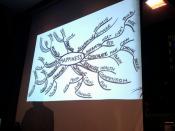The differences between happiness, joy and gladness1.IntroductionThe concept of happiness can be characterized by three separate prototypes, which all refer to happiness but each approaches the concept of happiness from a slightly different meaning. The differences reveal mainly in the intensity of the emotion. Therefore it is very interesting how these differences appear in the English language. It is important to see these differences because our society is based on happiness and to reach the main goal of oneÃÂs life it is good to understand the differences in the conceptualizations of happiness.
2.The three prototypesThe source domain of the three prototypes are taken from the class notes of Emotion Language, from the study of Zoltán Kövecses: Emotion concepts: from happiness to guiltA cognitive semantic perspective and definitions form answers.com.
The first prototype is called joy which according to answers.com is an ÃÂintense and especially ecstatic or exultant happiness and the expression or manifestation of such feelingÃÂ.
In other words, joy covers an immediate response of happiness. This means that this word is used to represent a sudden feeling that is ÃÂself-enabling and comes from withinÃÂ .
The next type is called the ÃÂexistential happinessÃÂ which is a major value in life that people want to reach. This is a general feeling about being happy, therefore it is expressed by the word happiness. In Answers.com this word is described as ÃÂan agreeable feeling or condition of the soul arising from good fortune or propitious happening of any kind; the possession of those circumstances or that state of being which is attended with enjoyment; the state of being happy; contentment; joyful satisfaction; felicity; blessednessÃÂ.
The last type of happiness is gladness, which is the less intense out of the three types. According to answers.com the word glad is ÃÂexperiencing...


